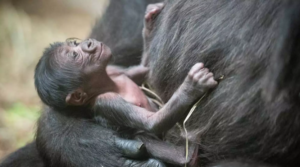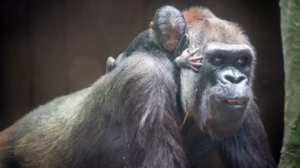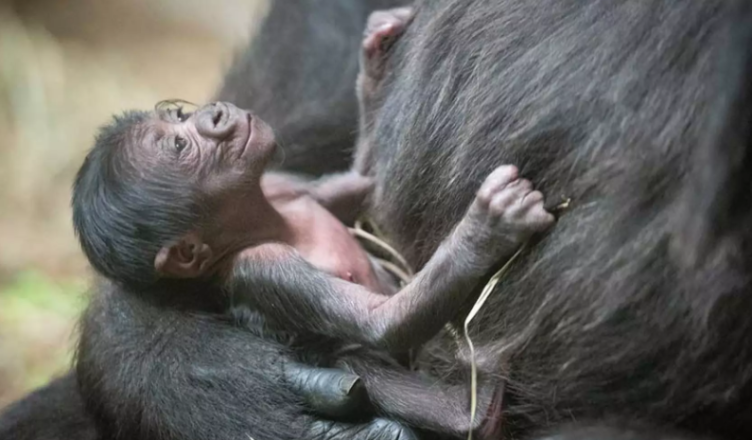For the first time in its 139-year history, the Cleveland Metroparks Zoo is welcoming a new baby gorilla to the troop.
The baby western lowland gorilla was born in late October weighing approximately three pounds, but preparations for innovative ways to care for him started well before that, said Cleveland Zoo Associate Animal Curator Elena Less. The mother, Nneka, had never had to care for a baby before and they weren’t sure how she would respond, Less said. So handlers began training certain behaviors among the zoo’s five gorillas using a stuffed animal they called “the baby.”
“They were all trained to pick up the baby, bring the baby over to the mesh at the back of the exhibit for a bottle so we can inspect the baby, and all sorts of behaviors with that stuffed animal,” Less said. “Our hope was that if Nneka decided to not show appropriate maternal care in the situation, we could ask any one of the other four to bring the baby over and then we could supplementally feed the baby.”
The baby’s father, Mokolo, hadn’t seen a baby gorilla before, Less said, and much like Nneka, staff weren’t sure how he would respond. But he adjusted well to the change and is showing interest in the baby’s development, Less said.
“I’m getting to see him be a first-time father, which is amazing. And he’s so gentle and it’s so instinctual,” Less said. “Not only experiencing what for me is the first gorilla birth I’ve ever experienced, but then seeing the dad go through the first birth, is fantastic.”
But Nneka did not have the same response. She gave birth earlier than expected, said Executive Director Chris Kuhar, and then didn’t seem to connect with the baby.
“She wasn’t really interested in caring for him, so we turned it over to the rest of the group and sort of let the rest of the group have access to the baby,” Kuhar said. “And Fredrika, our oldest female, walked right in, picked him up and has been holding him ever since. So she really responded immediately, kept him warm, kind of kept him safe.”

Fredrika, also known as Freddy, started to care for the baby as early as his first day, Kuhar said. Typically, baby gorillas are hand-reared by caretakers for a short period before being introduced to an adoptive mother, he said, and this might be the first example of a baby having a surrogate so early.
“We know that animal moms are the best moms. You know, we can provide food, but we can’t teach those behaviors. We can’t provide that level of care,” Kuhar said. “What we wanted to do is get the baby onto an adoptive mom as early as possible.”
Even though Freddy and the others stepped up to care for the baby, there was still another hurdle. Freddy wasn’t lactating, so she couldn’t feed the baby herself.
But handlers thought of that, too, Kuhar said. Prior to the birth, zoo staff trained Nneka to sit for a mechanical breast pump, just like human mothers would. Using that method, staff were able to extract colostrum from Nneka initially following the birth, Kuhar said. Now they feed the baby a mix of formula and orangutan milk.
“We’re seeing a baby who continues to be strong, seems to be growing,” Kuhar said. “We’ve got a long way to go, but so far, everything’s gone really well.”

The zoo hasn’t had a baby gorilla in its history. That’s because they haven’t had a group of adult gorillas capable of reproducing, Kuhar said.
The zoo first cared for a male and female pair in the 1980s, he said, but staff think now that the female wasn’t cycling. After that, the facility housed a bachelor pair – two adolescent male gorillas. Mokolo, the baby’s father, was one of those two gorillas.
When the other passed away, curator Less said, the zoo decided to bring in adult females to try and form a troop that could reproduce.
“Most zoos that house gorillas do actually house a breeding group and a bachelor group if they are able to. That’s not uncommon,” Less said. “I think what’s different is that we are really trying to use a lot of training, and we’re trying to stand on the shoulders of what our colleagues have already done in terms of the training and the maternal preparation and sort of build on that.”
They’re continuing that effort with the new baby gorilla, Less said.

“We’re learning each day what this baby tells us as we look at the social dynamics of the group and we see interest from other females,” Less said. “We’re learning, you know, hundreds of things every day, nuances on how this all works.”
Visitors can find the baby gorilla in the Primate, Cat and Aquatics building from 11 a.m. to 3 p.m., with the other members of his family.
